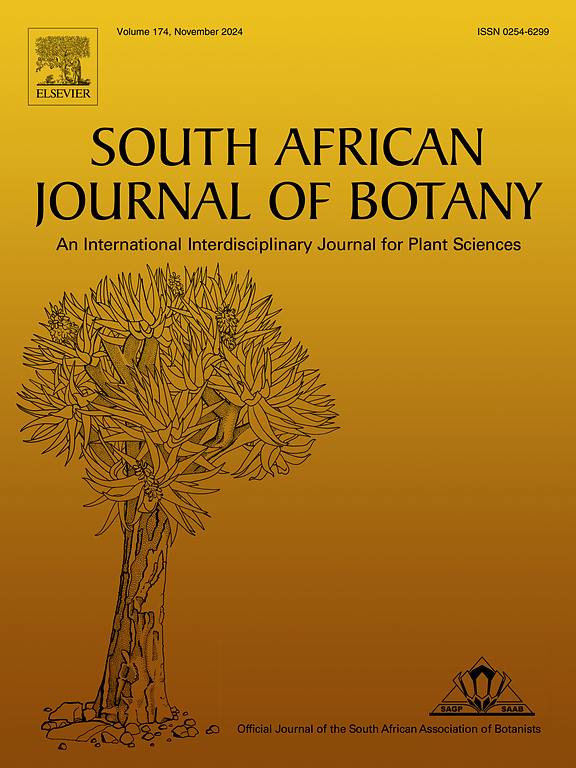形态,共生和分子生理地下适应营养匮乏的环境:一个南非的观点
IF 2.7
3区 生物学
Q2 PLANT SCIENCES
引用次数: 0
摘要
营养贫乏的生态系统被归类为可用营养物质已经退化、浸出或从系统中移除的生态系统。土壤年龄是影响土壤养分剖面的最重要因素,由冰川事件、构造活动和自然灾害决定。在古老和风化的土壤中,这些事件导致氮和磷的限制,而这两种主要的营养物质恰好限制了植物的生长和功能。利用从主要文献来源收集的数据,本综述的主要重点是在低营养环境下三种主要的地下适应的生理功能和机制工作。这进一步探讨了在营养贫乏的fynbos生物群系中发现的物种所使用的适应性。因此,在这种土壤上生长的植物必须进化出适应机制,以便在这些营养贫乏的环境中生存。这些适应使fynbos物种能够在这些营养贫乏的生态系统中茁壮成长,并分为两个广义术语,都专门用于获取P或N或两者兼而有之。豆科植物共生根结构,包括菌根真菌(MF)和根瘤的形成。根瘤是根系的侵染区,固氮根瘤菌在这里生长。另一种共生根结构,MF,允许植物-真菌根关联的广泛发展,显著增加植物根的吸收面积。非共生根结构包括蛋白质根或包括蛋白质科在内的几个植物科的簇根,它们是适应性生态性状,有助于在营养贫乏的环境中获取矿物质。丛枝根是一种结合代谢变化和形态变化的进化适应,以增加植物对磷的获取。我们对这些系统的理解主要来自生理背景,但未来多组学方法的应用将为控制对营养稀缺环境的适应的调节机制提供新的见解。本文章由计算机程序翻译,如有差异,请以英文原文为准。
The morphological, symbiotic and molecular physiological below-ground adaptations for nutrient scarce environments: A South African perspective
Nutrient-poor ecosystems are classified as those where available nutrients have been degraded, leached or removed from the system. The most important contributor to soil nutrient profiles is soil age, which is determined by glacial events, tectonic activity and natural disasters. In ancient and weathered soils, these events result in the limitation of both nitrogen and phosphorus, coincidentally the two primary nutrients that limit plant growth and function. Using data collected from primary literature sources, the main focus of this review was to contextualise the physiological function and mechanistic workings of three major below-ground adaptations in low-nutrient environments. This is further explored in relation to the adaptations used by species found in the nutrient-poor fynbos biome. Consequently, plants growing on such soils have had to evolve adaptive mechanisms that allow for survival in these nutrient-poor environments. These adaptations have allowed fynbos species to thrive in these nutrient-poor ecosystems and are divided into two broad terms, both of which are specialised for the acquisition of either P or N or both. Symbiotic root-structures including mycorrhizal fungi (MF) and the formation of nodules in the family Legumaceae. Nodules are an infected area of the root system where N-fixing rhizobia are housed. The other symbiotic root-structure, MF, allows for extensive development of plant-fungal root associations that significantly increase the absorptive area for plant roots. The non-symbiotic root-structures include the proteiod roots or cluster roots of several plant families, including the Proteaceae, that are adaptive ecological traits to assist with mineral acquisition in nutrient-poor environments. Cluster roots are an evolutionary adaptation that combines metabolic alterations with morphological changes to increase the plants acquisition of P. Our understanding of these systems in relation to fynbos species has mainly been from a physiological context but the application of multi-omics approaches in the future will provide new insights into the regulatory mechanisms that control adaptations to nutrient scarce environments.
求助全文
通过发布文献求助,成功后即可免费获取论文全文。
去求助
来源期刊

South African Journal of Botany
生物-植物科学
CiteScore
5.20
自引率
9.70%
发文量
709
审稿时长
61 days
期刊介绍:
The South African Journal of Botany publishes original papers that deal with the classification, biodiversity, morphology, physiology, molecular biology, ecology, biotechnology, ethnobotany and other botanically related aspects of species that are of importance to southern Africa. Manuscripts dealing with significant new findings on other species of the world and general botanical principles will also be considered and are encouraged.
 求助内容:
求助内容: 应助结果提醒方式:
应助结果提醒方式:


